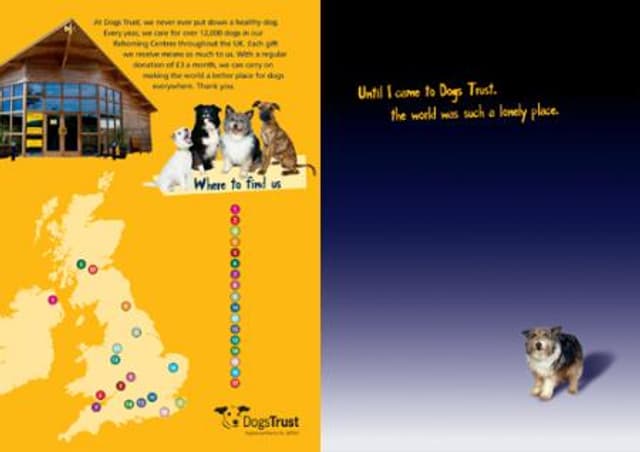Dogs Trust: sponsor a dog
- Exhibited by
- SOFII
- Added
- July 28, 2009
- Medium of Communication
- Broadcast and television, direct mail, online, posters.
- Target Audience
- Awareness, regular gift.
- Type of Charity
- Environmental/animals.
- Country of Origin
- UK.
- Date of first appearance
- Unknown.
SOFII’s view
An amusing story from the early days of the Dogs Trust ‘sponsor a dog’ scheme shows how the idea of dog sponsorship captured people’s imagination and even motivated donors to go to quite extraordinary lengths for ‘their’ dog. The 24 dogs first featured in the scheme were located in NCDL animal centres all round the UK. Initially, sponsors were encouraged to visit their dog, to take it for a walk. This proved so popular that some of the poor pooches were no sooner back from one walk than they were frog-marched off on the next. The idea had to be dropped because some dogs were in danger of having the legs walked off them. The agency creative teams had endless fun with this project in devising all the paraphernalia of the scheme, such as creating the promotional materials and writing the Valentine’s Day poems (doggerel). It’s not hard to see the appeal of this great fundraising proposition. Show these ads, mail packs and TV spots to, even, a roomful of fundraisers and invariably it'll be greeted by cries of ‘awwww!’. And, as all fundraisers should know, possession of the ‘aww’ factor is a sign of a surefire winner.
Summary / objectives
To transform an important animal welfare organisation by successfully re-launching a classic fundraising product.
Creator / originator
Burnett Associates Limited, with Adrian Burder at NCDL/Dogs Trust.
Background
Dogs Trust is the largest dog welfare charity in the United Kingdom. Every year, Dogs Trust looks after around 15,000 abandoned dogs at its nationwide network of 17 re-homing centres. The Trust aims to find new homes for all dogs and no healthy dog is ever destroyed. Until 2003, Dogs Trust was known as the National Canine Defence League (NCDL). Its main source of funding is the sponsor-a-dog programme. ‘Sponsor a dog’ started back in the 1960s by the then chief executive, Lieutenant Colonel A H Roosemale Cocq OBE MC who, for obvious reasons, was known as Rosy. When Rosy was appointed NCDL was over £100,000 in debt. Rosy set about transforming the organisation and one of his first decisions was to introduce a non-destruction policy. This meant that many of the charity’s dogs would be in NCDL’s care for long periods of time, so Rosy hit on the idea of putting these dogs up for sponsorship. Although dog sponsorship is a lovely fundraising product, it wasn’t developed for many years. Promotion was through leaflets and mentions in NCDL’s magazines. Sponsors would get a photo of ‘their’ dog when they joined but further communication was haphazard. There wasn’t a fundraising department until 1991 and until 1995 it consisted of just one person. By the end of 1994, dog sponsorship was raising around £90,000 a year — not nearly enough for the charity’s needs, particularly if it was to become a significant national organisation.
So NCDL instigated a major fundraising drive to enable the organisation to refurbish existing re-homing centres and build new centres. It was believed that substantial and dependable income streams could be developed by using direct marketing. One of the first major developments was the re-launch of dog sponsorship in the summer of 1995. The premise is simple: for a regular gift of a pound each week, you can sponsor one of NCDL’s longer-term residents and help to keep it, and the other dogs in NCDL’s care, safe and happy.
By developing the product (with agency Burnett Associates), NCDL set out to build strong relationships with its donors. Earlier letters to sponsors had been written as if they had come directly from the dog. Sponsors seemed to respond warmly to this and often replied to ‘their’ dog. It was also common for dogs owned by some sponsors to write back to the sponsored dog (obviously, donors were entering into the spirit of the sponsorship link with enthusiasm that far exceeded NCDL’s expectations). It was decided that this anthropomorphic approach was the way forward – the sponsored dog forming a relationship directly with the donor through letters, cards and other regular communication. The product was redesigned to ensure that sponsors would receive regular newsy updates from their dog. The first update was a Christmas card, the second a Valentine’s card. Handwritten envelopes and postage stamps were used to make these communications more personal. While donor response to the Christmas card was very positive, the response to the Valentine’s card was overwhelming. Several letters were received from elderly women who confessed to shedding tears of joy when they opened their card – as they had never received one before. One woman phoned NCDL’s head office to ask someone to explain what was happening to her boyfriend, as he thought she was having an affair. It was quickly realised that dog sponsorship had the ability to make donors smile – a rare event in direct mail fundraising. All materials were bright and cheerful with no harrowing images, so donors could open the mail without fear.
When sponsors join the scheme they receive a welcome pack featuring a canine ID card, a certificate of sponsorship, a fridge magnet and car sticker, followed by three updates a year from their dog. Sponsors also receive the Trust’s tri-annual magazine, Wag, to keep them abreast of what’s happening at Dogs Trust.
The first means of promotion was a mailing to the existing NCDL database. The head of fundraising at NCDL had no idea how successful this would be, just a hunch that it would work. The results were phenomenal, with ROIs of around 1:12 (for every £1.00 invested, an immediate response of £12.00 came back). This was followed up by testing recruitment advertisements in the UK national press which, again, proved phenomenally successful – one national newspaper providing an ROI of 1:7. As confidence in the product grew, it was decided to test the use of DRTV (direct response television). It was felt that a visual product such as the sponsor a dog scheme would lend itself well to the television medium. Again, results were fantastic with ROI’s of 1:4 or more achieved in the early days.
All the promotional materials were heavily anthropomorphic — dogs asking donors directly, ‘will you be my best friend?’ It proved irresistible. From the outset it was made clear that each dog had multiple sponsors (unlike child sponsorship schemes, which are almost invariably based on one child, one sponsor) but this seemed in no way to diminish the sponsors’ enthusiasm for the scheme. From that point in 1995, NCDL’s income began to rise exponentially. Today, Dogs Trust generates over £15m per annum from dog sponsorship — excluding Gift Aid (which can add another 15 to 20 per cent). Dogs Trust currently has 200,000 sponsors. So income has grown from £90,000 to £15m in just 12 years.
Details
A wide range of media has been tested — direct mail, press ads, advertorials, direct response television (DRTV), loose inserts, door drops, telephone, radio, outdoor posters, viral email (where recipients of Dogs Trust emails are asked to forward them to friends), online advertisements and face to face – it’s even been tried (unsuccessfully) on the sides of milk cartons. See here for the DRTV commercial.
As was expected, ROIs have dropped since the halcyon days of the mid 1990s but the product is still very profitable. The sponsor- a-dog product has evolved to ensure that efficient renewal, upgrade and reactivation programmes are in place. A website has been created and all materials are refreshed from time to time. But, at its heart, the product remains the same. A simple means of building a relationship between giver and beneficiary to encourage long-term support from our donors. We even have some dog sponsorship addicts who sponsor every available dog (currently 25) for £52 a year
Costs
See above.
Results
See above.
Merits
This is the classic ‘sponsor-an-animal’ fundraising product, developed to a very high degree of technical excellence, which has led to quite extraordinary fundraising success for its initiator, Dogs Trust.
Dog sponsorship is also a product that sits happily with the Trust’s brand. Dogs Trust is an upbeat, positive organisation that celebrates the dog/human relationship. Dog sponsorship reflects these values perfectly. In 1999, the Dogs Trust was left a legacy of £7.5m. The generous woman who had made this extraordinary gift was a dog sponsor.
See also Dogs Trust legacy advertising, the Canine Care Card, here, and various early Dogs Trust TV commercials, here.
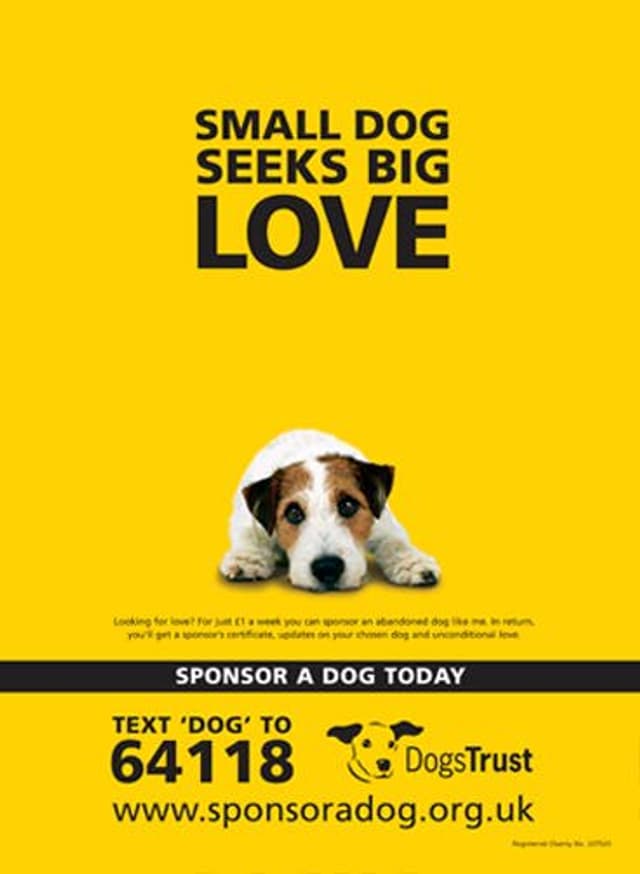
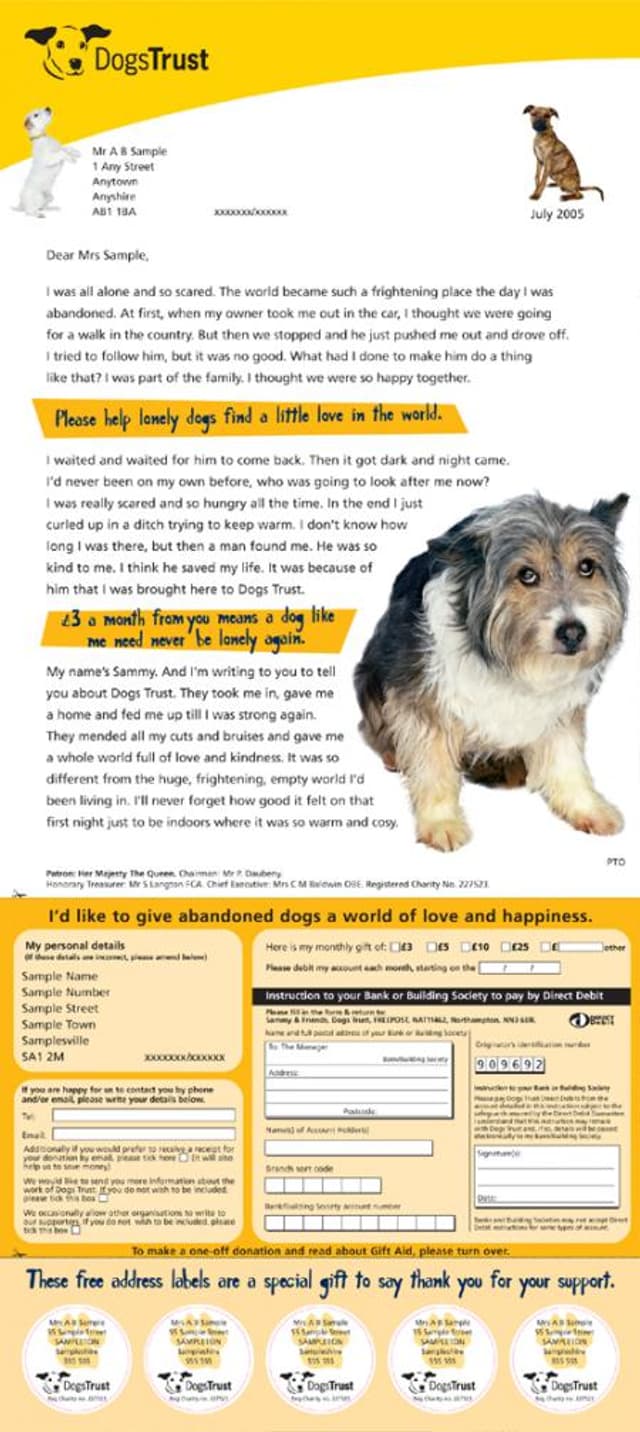 View original image
View original image
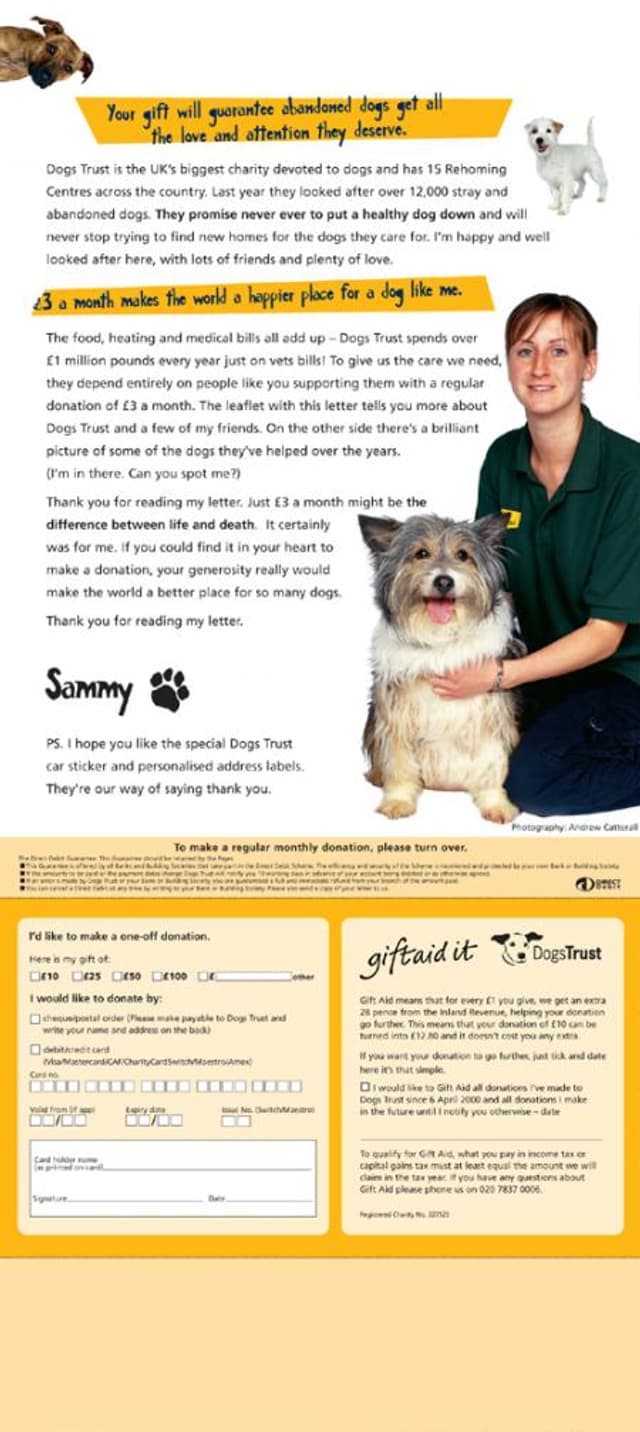 View original image
View original image
 View original image
View original image
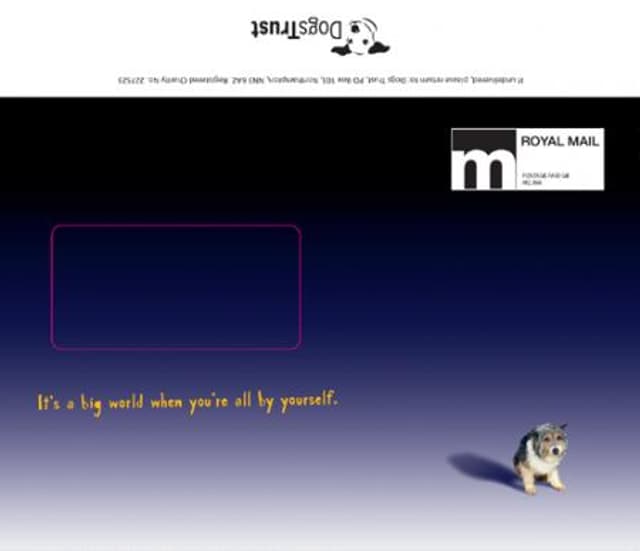 View original image
View original image



